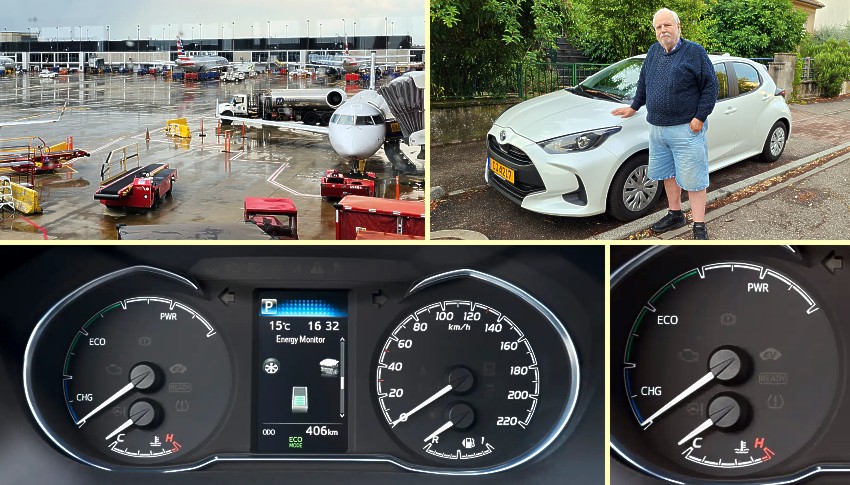Kansas Snapshots by Gloria Freeland - August 11, 2023
It's electric
Electricity had an impact in two unexpected, yet connected, ways on our July trip to France.
The first occurred in Chicago, where our arrival was a little bumpy due to local storms. But then we sat on a taxiway for a couple
of hours. We were told that all outside ground workers were to stay inside for 15 minutes after a lightning strike within five miles
of the airport. Repeated strikes meant the plane at our gate couldn't be serviced and so, we waited. Once at the gate, more strikes
meant our luggage was stranded in the plane. Additional ones delayed our departure. Our two-hour connection window in London began
to look "iffy."
We arrived in London an hour later than scheduled and found we were already re-booked on the 5 p.m. flight. Our expected two-hour
layover had become a 10-hour one!
But with no appointments to meet, the 8:20 p.m. arrival at our destination airport in Luxembourg just meant we'd be a bit more tired
making the 45-minute drive to our place in Metz.
In the spring, we had a similar delay, and Art had been worried our rental car might be gone. When he called the company, no one
answered, but that evening he received an e-mail from the company asking if we were still coming. When he told them we were, the
response was "No worries." They know things happen, and their policy is to hold the vehicle 24 hours. And since this time Art had
prepaid, why wouldn't they hold the car?
It was a different company and the rules were different ... the car was NOT held.
Art had a heated exchange with the clerk, which ended when Art said he'd take it up with the company. He added that he understood
she was just carrying out the company's policies. The clerk's demeanor changed completely at that point, and she told him she had a
great car for us that we'd love. It was a Yaris SUV.
I had never heard of the brand, but Art said it was a Toyota model, so it was a reputable manufacturer. And we realized the
additional room afforded in an SUV might be handy when daughter Katie and hubby Matt arrived a few days later.
Many terms used in the auto industry have no precise meaning, and SUV - Sports Utility Vehicle - is one of them. Traditionally,
SUVs are a blend of an ordinary car with an off-road type, featuring traits such as higher ground clearance. This blend typically
has made them somewhat larger. But when we arrived at our car stall, the car looked more like a compact. With 9 p.m. approaching
and a drive ahead of us, neither of us was in the mood to complain. The luggage compartment/trunk looked rather small, yet our
oversized suitcase fit quite well.
Then it got weird!
When Art tried to start the engine, it ran for perhaps two seconds, then quit. Repeating the process brought the same results. Art
kept trying different things, such as keeping his foot on the brake, but to no avail. But we noticed that in the hot parking garage,
the car was cooling. How could that be?
Suddenly he looked at me and said, "I think this car may be electric."
He placed the shift into "drive," and took his foot off the brake. In almost complete silence, we pulled out of the stall. The only
sounds were a faint tone perhaps near middle-G, and the rubber tires squeaking against the concrete floor when Art turned the
steering wheel. Soon we were zipping through the garage toward the exit in almost complete silence. The Chicago electrical storm had
culminated in our driving our first electric vehicle!
Art said what tipped him off was the gauge where a tachometer - the instrument that measures the working speed of a vehicle's
engine - would typically be. It was divided into three areas. It had a needle, but the areas were labeled - PWR, ECO and CHG. I
guess they were even being economical with letters!
Since we knew the route well, we were free to concentrate on the car. I thought it was quite comfortable, and Art said that in
almost every respect, it drove like an ordinary car. But pressing down on the accelerator pedal caused the odd-gage needle to move
from ECO to PWR. Hitting the brake made it move to CHG. Art said that rather than the energy of the car being thrown off as heat
when he stopped or slowed as in a "normal" car, it was being transferred back to the battery.
It was not an all-electric powered car, but a hybrid. But not like the Prius. The Yaris ran completely on battery power until
charging was required. Then the three-cylinder engine would start and replenish the battery.
Over the next three weeks, there were two things we never quite became accustomed to: the air conditioning working without the
engine running and the engine suddenly starting on its own when the system decided recharging was required.
Other things we adjusted to quickly. When I watched other people get in their cars and we heard the engines crank, for an instant I
thought, "How weird is that?"
The car was exceptionally smooth and quiet, cooled down quickly on hot days, and made 60-miles-to-the-gallon. The nine-gallon fuel
tank meant stopping to refuel was easy on the pocketbook, even with Europe's high fuel prices.
Since we usually drive large sedans where the goal is smooth travel, we never pushed the car hard. But it easily climbed steep
nearby hills and, when asked to pass, it had plenty of zip. To be candid, the car the Chicago electrical storm had led us to was
fun to drive.
As often happens in life, problems sometimes may be opportunities in disguise!
